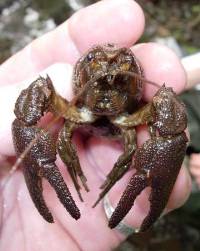Endangered crayfish find haven in Northumberland
![]()
Endangered crayfish find haven in Northumberland
Nov. 21, 2007
Northumberland Gazette
ONE of Britain's most endangered native animals is alive and thriving in
Northumberland.
A survey carried out on a stretch of the River Wansbeck that flows through the National Trust's Wallington Estate has revealed the area as one of the top sites in England for the endangered White-clawed crayfish.
The white-clawed crayfish is one of Britain's most endangered native animals.
Numbers have declined dramatically as a result of the impact of the American signal crayfish, which are larger, more aggressive and carry the crayfish plague, a disease that is fatal to white-clawed crayfish.
The pollution of rivers and degradation of river habitats by inappropriate land management practices have also played a substantial part in their decline.
The survey work was carried out by National Trust Warden John Jamieson over a two-week period.
Data and information gathered has been used to help evaluate the abundance of the white-clawed crayfish, any threats to the population from the American signal crayfish and the quality of the habitat.
Both of the burns surveyed had a high or very high abundance of crayfish and the results revealed that there was a chance of finding a crayfish under two out of every three of the stones that they use as refuges.
In total, eight sample sites were monitored during the two-week survey and 250 White-clawed crayfish were found in 400 refuges. The lack of crayfish on nearby burns has been linked to land use, such as cattle grazing, close to the river.
John Jamieson, National Trust warden at the Wallington Estate, said: "Results from this survey have confirmed that the River Wansbeck is an internationally-important stronghold for the white-clawed crayfish.
"We now have the data to help focus our work on how we can further strengthen their habitats and make sure that the crayfish can flourish."
